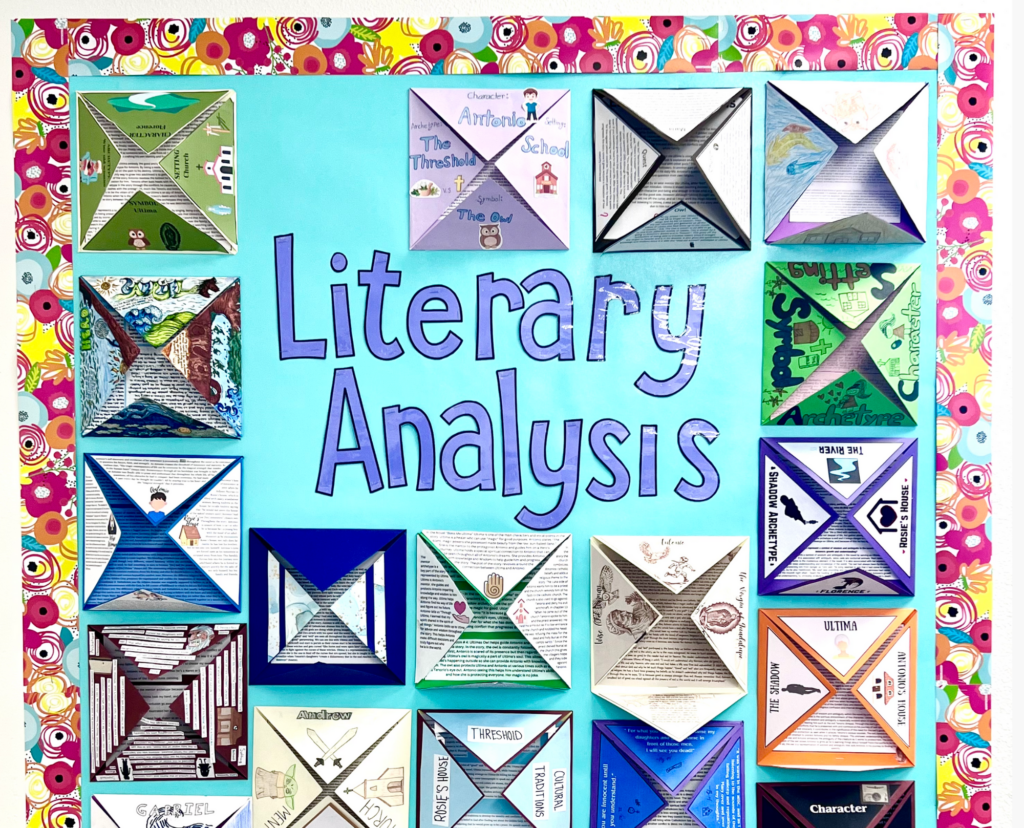
At the end of each novel I teach, I like to have my students participate in some sort of culminating literary analysis project that allows me to assess their understanding of the novel, its major literary themes, and other elements of literary significance. Sometimes the end-of-novel literary analysis assessment will be the literary analysis essay and sometimes it is more of a hands-on project. Whatever I choose, I like to provide my students wil creative literary analysis activities throughout the year.
When it comes to a culminating literary analysis project, I like to vary the requirements from project to project so that students have multiple opportunities to demonstrate their understanding and creativity. Recently, with my honors sophomore class, the cumulative literary analysis project they completed was a literary analysis square off of our class novel Bless Me Ultima. This blog post does contain affiliate links, and contains helpful literary analysis activities for middle school and high school!
The Literary Analysis Creative Square: A Cumulative Literary Analysis Project
I took this idea for the literary analysis create square project from the artistic PAPA square project and modified it to fit my needs for the Bless Me, Ultima unit my students were working on. For this project, I provided each student with a piece of 12×12 inch cardstock and encouraged them to use printer paper on top if they wanted to add more color to their project.
For this project, I divided the work up into three categories: the front inside (the square inside the flaps), front outside (the outside triangle flaps), and back (the back of the literary analysis project).
Planning the Front Inside of the Creative Literary Analysis Square Project
There is a large square on the front inside of this project. For the Bless Me, Ultima literary analysis project I assigned my students, I had students respond to three of the five provided essential questions. These were essential questions that I provided my students with at the beginning of our unit, and we discussed them at length throughout the unit.
On your copy of the literary analysis project, double click on the image, and then you can edit the contents of the this portion of the project. If answering essential questions isn’t your jam, you could also have your students write a paragraph or two discussing how the author develops the novel’s theme.
Planning the Front Outside of the Creative Literary Analysis Square Project
The front outside of this artistic literary analysis project has four triangular flaps. For this part of the project, I had my students look at the four main literary elements we studied and discussed in-depth during our unit: character, setting, symbol, and archetype.
For each of these literary elements, students selected one topic for each category and provided a cited quote and several sentences explaining the significance of that element in the novel. This also served as an excellent novel review because I had my students share their projects at their table groups before the final novel test!
Here is a list of possible literary elements you can choose to do with your own literary analysis project:
- character
- setting
- symbol
- archetype
- conflict
- protagonist (if you want to focus more on character)
- antagonist (if you want to focus more on character)
- motif
For the outside flaps of the literary analysis project, the possibilities really are endless! Simply select which ones your want your students to focus on and edit the document!
Also, with this portion of the project, I give the students more freedom. I let them know they can either add the information to the outside or the inside of the flap. This is where many of the students choose to add in artistic elements.
Planning the Back of the Creative Literary Analysis Square Project
For the back of the project, I wanted to provide my students with an opportunity to reflect on their thoughts about the book and provide a rating or a review for the book. On the back, I had my students write an 8-10 sentence reflection on the book as well as provide a review with a rating system. I encouraged a lot of creativity here with the rating system, and my students did not disappoint.
Teaching Literary Analysis
Teaching literary analysis can be fun, engaging, and accessible for all students! When I teach literary analysis to my students, I use this hands-on sticky note unit to increase student engagement and understanding. Students enjoy using sticky notes in class as they analyze the author’s use of various literary devices in complex short stories and novels.
This sticky note literary analysis unit is a great way to help students learn to thoroughly analyze literature. By focusing on just one or two devices at a time, students are better able to understand how the device is used and why it is effective!
Here is what fellow teachers say about this unit:
⭐️⭐️⭐️⭐️⭐️ Extremely satisfied
“My students found this very helpful to organize their writing and the movement involved with using sticky notes was a hit. The kids loved getting to use sticky notes and to flip them up and down. It made the planning for their writing so much faster. Would highly recommend for all students but especially for any kids who have a hard time focusing.”
⭐️⭐️⭐️⭐️⭐️ Extremely satisfied
“This is a great way to have kids write literary analysis in a different way instead of just asking for essays. It’s like a little trick to get them to do academic work while thinking they are just doodling on sticky notes. I even use this with AP Lit and just modify my expectations somewhat. I appreciate all the different handouts/options.”

